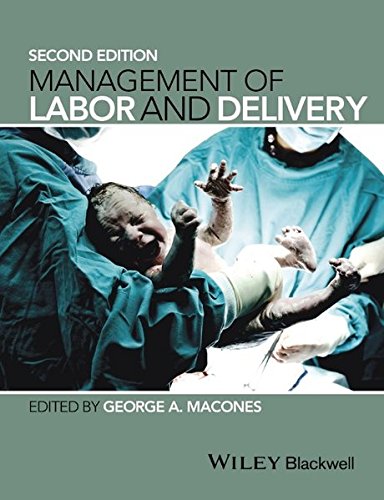(EBOOK PDF)Management of labor and delivery Second Edition by George Macones 9781118327296 1118327292 full chapters
$50.00 Original price was: $50.00.$35.00Current price is: $35.00.
Management of labor and delivery Second Edition by George Macones – Ebook PDF Instant Download/Delivery: 9781118327296, 1118327292
Full download Management of labor and delivery Second Edition after payment
Product details:
• ISBN 10:1118327292
• ISBN 13:9781118327296
• Author:George Macones
Management of Labor and Delivery
The process of labor and delivery has been one of the most perilous activities in human life. The awkward evolutionary compromises giving rise to humans makes birthing potentially life threatening for both mother and child. Despite the development of modern care, labor and delivery continues to be a dangerous process even though the levels of fatality have decreased over the past several decades.
This clinically focused guide to modern labor and delivery care covers low and high-risk situations, the approach of the team in achieving a successful outcome and what to consider when quick decisions have to be made. Aimed at both trainee and practicing obstetrician-gynecologists, this new edition includes practical guidance such as algorithms, protocols, and quick-reference summaries. It is squarely focused on the process of birth and concentrates on modern clinical concerns, blending science with clinical applications.
Management of labor and delivery Second Table of contents:
Contributor List
CHAPTER 1: Antenatal preparation for labor
1.1 Introduction
1.2 Goals of antenatal childbirth education
1.3 Theoretical approaches to antenatal childbirth education
1.4 Effectiveness of childbirth preparation: educational goals and pregnancy outcomes
1.5 Future direction for advancing antenatal childbirth education
1.6 Who teaches childbirth education classes and where?
1.7 Prenatal education class content
1.8 Group prenatal care
1.9 Self-prepared birth plans
References
CHAPTER 2: Normal labor and delivery
2.1 Introduction
2.2 Labor onset
2.3 First stage of labor
2.4 Second stage of labor
2.5 Third stage of labor
2.6 Intrapartum care during normal labor and delivery
2.7 Conclusion
References
CHAPTER 3: Management of labor and delivery in low-risk subjects
3.1 Introduction
3.2 First stage
3.3 Amniotomy
3.4 Second stage
3.5 Perineal massage
3.6 Episiotomy
3.7 Cord clamping
3.8 Third stage
3.9 Conclusion
References
CHAPTER 4: Induction and augmentation of labor
4.1 Introduction
4.2 Indications and contraindications for induction or augmentation of labor
4.3 Risks associated with labor induction
4.4 Predicting success of labor
4.5 Mechanical cervical ripening
4.6 Biochemical agents for cervical ripening
4.7 Oxytocin
4.8 Active management of labor
4.9 Failed induction
4.10 Safety and quality protocols
4.11 Conclusion
References
CHAPTER 5: Fetal monitoring and assessment
5.1 Introduction
5.2 Historical perspectives
5.3 Intrapartum electronic fetal monitoring
5.4 Fetal scalp sampling
5.5 Fetal pulse oximetry
5.6 Fetal ST segment analysis
5.7 Research and the future
References
CHAPTER 6: Operative vaginal delivery
6.1 Introduction
6.2 Indications, contraindications, and prerequisites for operative vaginal delivery
6.3 Classification system for operative vaginal delivery
6.4 Technical aspects of operative vaginal delivery
6.5 Effectiveness of operative vaginal delivery
6.6 Maternal morbidity
6.7 Pelvic floor dysfunction after operative vaginal delivery
6.8 Neonatal morbidity
6.9 Long-term neonatal outcomes
6.10 Mode of delivery: sequential instruments versus cesarean section
6.11 Subsequent pregnancy outcomes following operative vaginal delivery
6.12 The future of operative vaginal delivery
6.13 Conclusion
References
CHAPTER 7: Cesarean delivery
7.1 Introduction
7.2 Cesarean technique
7.3 Postcesarean delivery care
7.4 Considerations for cesarean under special scenarios
References
CHAPTER 8: Trial of labor after cesarean
8.1 Background
8.2 Risks of trial of labor after cesarean
8.3 Predictors of vaginal birth after cesarean
8.4 Uterine rupture
8.5 Pregnancy management
References
CHAPTER 9: Malpresentation and malposition
9.1 Introduction
9.2 Malpresentation
9.3 Malposition
9.4 Conclusions
References
CHAPTER 10: Multiple gestations
10.1 Introduction
10.2 Perinatal and maternal complications
10.3 Intrapartum preparation
10.4 Timing of delivery
10.5 Delivery
10.6 Vertex/vertex
10.7 Vertex/nonvertex
10.8 Nonvertex first twin
10.9 Cesarean delivery
10.10 Special cases
10.11 Special procedures
10.12 Conclusion
References
CHAPTER 11: Obstetrical emergencies
11.1 Background
11.2 Postpartum hemorrhage
11.3 Shoulder dystocia
11.4 Umbilical cord prolapse
11.5 Head entrapment
11.6 Seizure
11.7 Cardiopulmonary arrest and perimortem cesarean delivery
11.8 Summary
References
CHAPTER 12: Surgical management of obstetrical emergencies
12.1 Introduction
12.2 Uterine tamponade and packing
12.3 Uterine compression sutures
12.4 Uterine compression suture technique
12.5 Uterine artery ligation
12.6 Combination procedures for uterine preservation
12.7 Hypogastric artery ligation
12.8 Peripartum hysterectomy
12.9 Retained placenta
12.10 Obstetric laceration
12.11 Acute postpartum hematoma
12.12 Emergency cesarean
12.13 Perimortem cesarean
12.14 Conclusion
References
CHAPTER 13: Maternal disorders affecting labor and delivery
13.1 Hypertensive disorders of pregnancy
13.2 Gestational hypertension
13.3 Chronic hypertension/superimposed preeclampsia
13.4 Preeclampsia
13.5 Management of preeclampsia in labor
13.6 Eclampsia
13.7 Cardiac disease
13.8 Pulmonary disease
13.9 Renal disease
13.10 Diabetes
13.11 Neurologic disorders
13.12 Infections
References
CHAPTER 14: Fetal disorders affecting labor and delivery
14.1 Growth disturbances
14.2 Hemophilia
14.3 Skeletal dysplasias
14.4 Genetic abnormalities
14.5 Cardiac defects
14.6 Abdominal wall defects
14.7 Myelomeningocele
References
CHAPTER 15: Labor and delivery management of the obese gravida
15.1 Intrapartum management
15.2 Cesarean section
References
CHAPTER 16: Intrapartum and postpartum infections
16.1 Introduction
16.2 Group B Streptoccocus
16.3 Varicella
16.4 Urinary tract infections / pyelonephritis
16.5 Parvovirus
16.6 Listeriosis
16.7 Human immunodeficiency virus / acquired immunodeficiency syndrome
16.8 Chorioamnionitis
16.9 Rubella
16.10 Toxoplasmosis
16.11 Hepatitis B
16.12 Hepatitis C
16.13 Cytomegalovirus
16.14 Herpes
16.15 Wound infections
16.16 Endometritis
16.17 Septic pelvic thrombophlebitis
16.18 Mastitis
References
CHAPTER 17: Obstetric anesthesia
17.1 A brief history of obstetric anesthesia
17.2 Anesthetic implications of the physiology of labor and delivery
17.3 Pain sensation in pregnancy, labor, and delivery
17.4 Management of pain in labor and delivery
17.5 Neuraxial techniques
17.6 Surgical anesthesia for the parturient
17.7 Non-delivery surgical anesthesia for the parturient
17.8 Hypertensive diseases of pregnancy
17.9 Management of obstetric hemorrhage
17.10 Anesthetic implications of specific maternal co-morbidities
References
CHAPTER 18: Postpartum care
18.1 Goals of care
18.2 Postpartum physiologic changes
18.3 The fourth stage of labor
18.4 Complications
Acknowledgments
References
CHAPTER 19: Development of an obstetrical patient safety program
19.1 Introduction
19.2 Background and fundamentals of patient safety
19.3 Building blocks of an obstetric patient safety program
19.4 Measuring patient safety
19.5 The evidence on quality improvement in obstetrics
19.6 Conclusion
References
Index
End User License Agreement
Read Less
People also search for Management of labor and delivery Second:
management of labor
active management of labor
what is expectant management of labor
active third stage management of labor
nursing management of labor
Tags:
Management of labor,labor and delivery,George Macones




